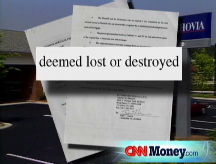Over the horizon, a housing recovery
Harvard report finds immigration, other demographic trends will fuel housing demand over the next decade.
| 30 yr fixed | 3.80% |
| 15 yr fixed | 3.20% |
| 5/1 ARM | 3.84% |
| 30 yr refi | 3.82% |
| 15 yr refi | 3.20% |
NEW YORK (CNNMoney.com) -- The current housing market is bleak: home prices and sales are plummeting, foreclosure proceedings are skyrocketing and mortgage rates are on the rise.
When will things be better?
A new study from the Joint Center for Housing Studies of Harvard University, "The State of the Nation's Housing 2008," finds the country poised to see an increase in housing demand over the next decade.
"The good news is that we still have a growing population," said Nicolas Retsinas, director of the Joint Center for Housing Studies and one of the study's authors. "As long as you have more households, more people are going to need places to live."
Social trends - people getting married later and divorced more often - are making single-person households the fastest growing household type, the study finds. In addition, a long-term net increase in potential home buyers will be driven by demographic factors: the aging of "echo boomers" into adulthood, an increased life expectancy for baby boomers and projected annual immigration of 1.2 million.
From 2010 to 2020, the number of households in the United States will grow by an average of more than 1.4 million per year, the study finds.
Unsold homes block growth
Still, before the housing market can turn around, it must first work off the record numbers of unsold homes on the market. From 2005 to 2007, the number of new and existing vacant homes for sale rose 46% to 2.12 million.
The nationwide glut of unsold homes has hit the real estate market hard, forcing down sale prices, stemming new construction and leaving millions of homeowners with properties worth less than the value of their mortgage.
In early 2008, the nation had an 11-month supply of unsold new homes and a 10.7-month supply of existing single-family homes, according to the Harvard study. A six-month supply of existing homes is considered a buyers' market. Reducing the current supply will require price declines, a decrease in interest rates, employment growth, a return of consumer confidence and the revival of accessible mortgage credit.
A reduction in new home construction is another key to decreasing inventory, Retsinas said. Privately owned housing starts fell 3.3% to a seasonally adjusted annual rate of 975,000 in May from 1 million in April, according to the Commerce Department.
A sharp drop-off in housing starts has precipitated housing turnarounds in previous bubble-bust cycles, said Karl Case, a Wellesley College economics professor and a co-founder of real estate consulting firm Fiserv CSW. Case also sees long-term growth in the housing market and agrees that immigration and other demographic trends will help fuel a long-term recovery.
"If household formation continues at pace, prices will recover and starts will rise again," Case said.
In the housing bust of the early 1990s, cities with big immigrant populations, like Los Angeles, recovered more quickly than other metropolitan areas, like Boston, with lower foreign-born, said Case.
"Not all immigrants buy houses, but many immigrants buy houses," Case said. "That has a positive effect on the prices in a market."
Regional recoveries
Retsinas said parts of the country, such as the Northeast, with fewer vacant homes could see signs of a recovery in spring 2009. He was less sanguine about markets like the Southwest, where excessive overbuilding at the height of the market means it could take two years or more to sell off excess inventory.
Recovery in the Midwest represents that biggest challenge, because the housing downturn there stems from regional economic problems beyond overbuilding.
"They're not reacting to an overheated housing market there," Retsinas said. "They live in an economy that is shedding jobs." ![]()




